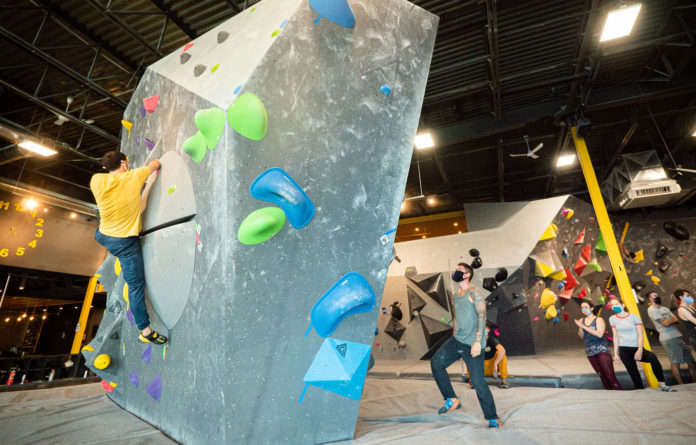
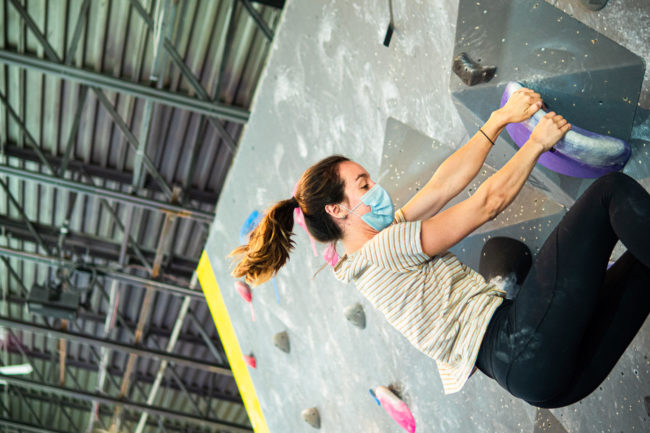
With the onset of the COVID-19 global pandemic, cities around the world went into lockdown to slow the spread of the virus. People were encouraged to stay home and businesses that involve people congregating indoors, such as restaurants, movie theaters, and fitness gyms, were forced to close in many jurisdictions. Months later, most climbing gyms in North America have been able to reopen in some capacity, but the latest wave brought about new temporary closures. The pandemic is still a concern, yet the long-term outlook for the industry is positive. Numerous new gyms have held their grand openings during this period, and many more are planned for 2021.
“Peoples will always want to get back to the gym because it’s a social space,” said Lisa Lajoie, co-founder of Délire Climbing Walls. Délire produces walls and flooring for climbing gyms, consults on gym design, and owns and runs three successful gyms around Quebec, Canada. Rather than dwell on the hardship this new era brings, Lajoie is confident that climbing gyms will continue to be a wanted and needed contribution to society. The trick is figuring out how to keep gyms safe, affordable and successful.
Mitigation protocols have been essential to reopening as safe as possible during this period. From reservations to masks and distancing, climbing gyms have been working hard to set a high standard for the industry, including Délire’s three gyms in Quebec.
“Three major steps have been taken to ensure the safety of our members,” said Jean-François Beaulieu, the other co-founder of Délire Climbing Walls, about Délire’s gyms. “First, we manage occupancy flow with a live widget on our website. This encourages members to come during less-busy periods. Second, we extended our hours of operation and enforced a 90-minute climbing time. This allows us to have almost as many daily visits as before. Third, we split the gym into two zones to contribute to social distancing.”
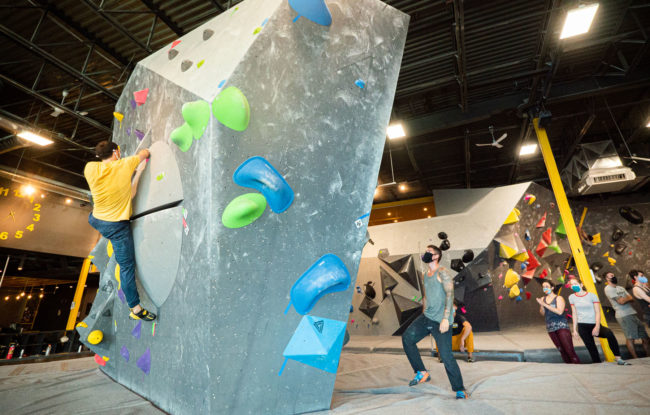
Living Space
In addition to operation strategy, gym operators can set themselves up for success well before their doors are first opened. Designing a gym with enough space is crucial, both for distancing in the pandemic era and an enjoyable climbing experience in general.
“We have recommended more floor space in gyms for a long time, and our experience shows it,” said Beaulieu, who like Lajoie are both accomplished climbers and have been managing gym projects for 15 years. “Our last gym is clearly the most lucrative, and it is not the biggest. This is because you need a perfect mix of climbing surface and chilling spots. Covid is just one more example showing why living space is important.”
People want places to lounge between tries on boulder problems, space to watch their friends try difficult moves, and a place to just hang out together. “A climbing gym is more than a climbing wall for sporting purposes,” said Beaulieu. “It is a social environment, and seeing it thus we can engineer the right proportion of elements.” In this era of social distancing, room inside a gym is even more important. More open space means climbers can be further apart and, even with less climbing wall surface, can facilitate more climbers in the gym at one time.
“A perfect gym is open and easy to move around in even if it’s full,” said Beaulieu. “There is a warm space for before and after climbing. In this space we celebrate, we relax, we dream of our future.”
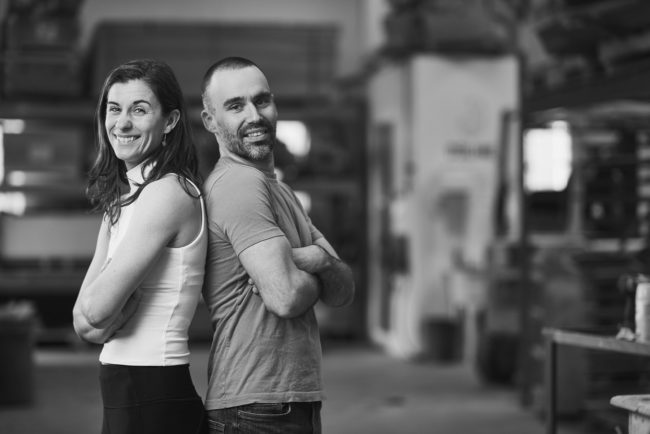
Small is Beautiful
All this talk of space does not necessarily mean that climbing gyms need to be huge to be successful. According to Lajoie, a more important factor is making sure that gyms of any size are well designed. This is something that Délire focuses on in its own gyms and in the company’s designs for new gym owners.
“There is a desire to try to have the biggest, most impressive installation, but sometimes when the gym begins to operate, things don’t go as planned,” said Lajoie. “The classic example is the ”arch” that was really popular a couple of years ago. People were asking for this type of structure, but we realized that routesetters won’t necessarily use this feature. They were paying for something that looks good, but that not many climbers used in the end.”
Instead, Délire’s designs focus on smaller features and more space for climbers to inhabit. The company also finds ways to inhabit existing space better, which sometimes means putting a stand-alone structure in a large space so that the interior of an existing building won’t need expensive reinforcements. Stand-alone structures like this can be multi-purpose and provide storage for climbing holds and other supplies.
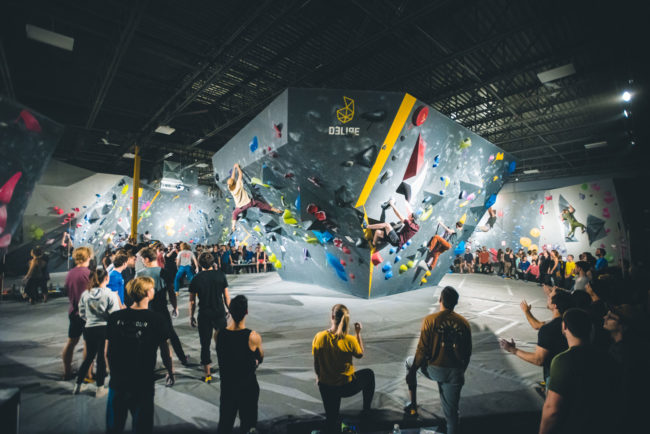
Indoor Climbing Moves Outdoors
As developers consider opening new gyms in the pandemic environment, keeping projects small and spacious is important, but this does not mean that one’s ambitions need to be small. Délire sees room for gym owners to develop thoughtful interior spaces and even expand by adding outdoor structures.
“We launched a new line of outdoor structures for commercial and personal use,” said Lajoie. “The idea is to multiply options and smaller climbing spaces so it’s more accessible for everybody in the long term.”
States across the US have rolled out different reopening measures this year. For example, California’s four-tiered reopening system has been in the spotlight of late. While climbing centers in the most restrictive tier remain closed and facilities in other counties are only allowed to reopen indoor activities at limited capacity levels, outdoor activities with restrictions are permitted across all tiers. In warm, temperate locales, such as southern California, outdoor climbing structures as companions to indoor gyms may be an elegant way to continue offering climbing to customers in a safe manner. Plus, outdoor climbing is fun, and it’s just one more reason for climbers to come back.
“The new trend this year seems to be around ice climbing initiation,” said Lajoie, speaking of Canada, where Délire is based. “If you create an outdoor structure close to your main installation, then it’s a new, fun way to be outdoors together, even when it’s cold.”
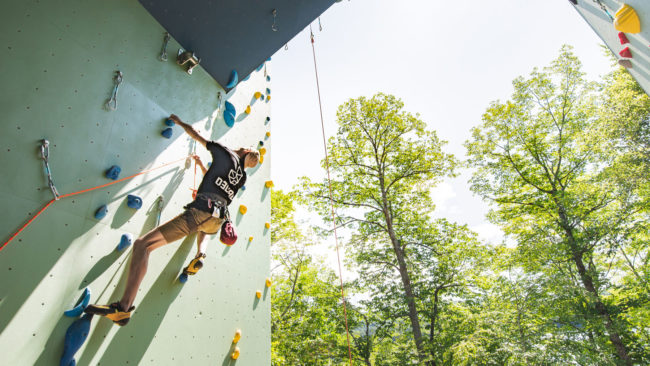
Creating a Gym in Phases
But in this time of reduced capacity levels, it may seem daunting for a gym to afford an outdoor structure, remodel their gym to incorporate more living space, or for a new gym to start from scratch. This is why Délire advocates for project phasing, or building a gym in parts.
“Project phasing is a really interesting strategy for the future gym operator, especially in uncertain times like we are seeing today,” said Lajoie. “You can also much more easily sell your project to a bank because phasing will make the first step less expensive.”
Project phasing also allows a gym operator to learn about the customer base before committing money to a larger design. For example, when writing an initial business plan, an owner may assume that roped climbing will be the most popular, but when the gym is open, learn that most of the customers come to boulder. This knowledge can inform the second phase of the gym construction in the way that will be most desirable for its customer base and, in turn, most profitable for the operator.
All these strategies, from adding more open space to a gym’s floorplan, to building small outdoor structures, to constructing or remodeling a gym in phases, are adaptations for successfully running a gym during a pandemic era. However, these are also evolutions in what makes a good gym anytime. Beloved gyms cater to people’s needs, include people of all backgrounds and abilities, and are pleasant spaces to inhabit. According to Lajoie, a gym designed with these philosophies stands a better chance of attracting more customers, building a tight-knit community, and succeeding as a business.
“The sport [of climbing] is evolving more and more into a common activity like basketball or classical gym training,” said Lajoie. “During the pandemic, people will do yoga at home in front of their laptops, but we will all be happy to get back to class, see friends, and exist as a community. Creating many more little climbing spaces will make climbing more accessible, whether there’s a pandemic or not.”
.

DÉLIRE Climbing Walls designs and builds sustainable climbing walls and gyms of the highest quality and integrity and is the manufacturing arm of DÉLIRE Escalade, which operates multiple indoor climbing gyms and an outdoor bouldering gym in Quebec, Canada.






